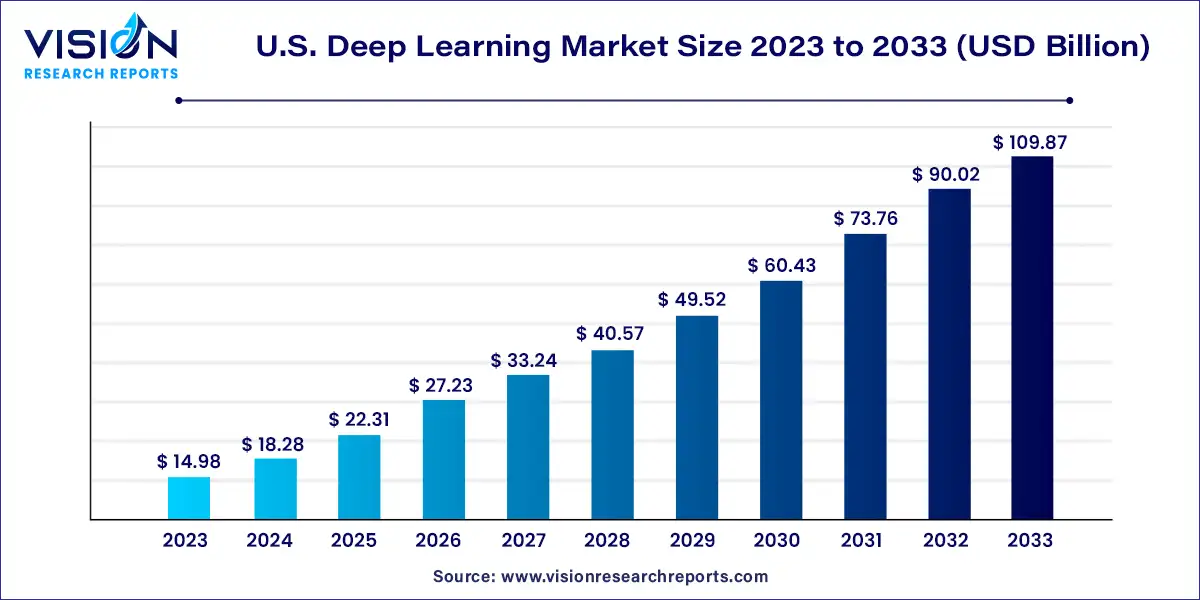The U.S. deep learning market size was estimated at around USD 14.98 billion in 2023 and it is projected to hit around USD 109.87 billion by 2033, growing at a CAGR of 22.05% from 2024 to 2033.

The U.S. deep learning market has witnessed significant growth in recent years, driven by advancements in artificial intelligence (AI), increasing adoption of deep learning technologies across various industries, and growing investments in research and development.
The growth of the U.S. deep learning market is propelled by an escalating adoption of deep learning technologies across diverse industries. This adoption is fueled by the desire to enhance decision-making processes, improve operational efficiency, and capitalize on new business opportunities. Additionally, advancements in artificial intelligence (AI) and machine learning algorithms play a pivotal role in accelerating the development and deployment of deep learning solutions. The increasing availability of vast datasets further boosts market growth, enabling more robust training and validation of deep learning models. Moreover, the rising demand for autonomous systems, such as autonomous vehicles and intelligent virtual assistants, underscores the importance of deep learning in enabling such technologies.
In 2023, the software segment dominated the market with a contribution of 48% in revenue, marking the largest share. This growth is primarily driven by the availability of robust tools, extensive programming capabilities, and libraries facilitating the training, design, and validation of deep neural networks. Moreover, stakeholders have intensified their investments in edge intelligence, machine comprehension, and the ONNX (Open Neural Network Exchange) architecture, bolstering deep learning adoption across various business verticals.
Meanwhile, the hardware segment is poised to exhibit the fastest compound annual growth rate (CAGR) during the forecast period, fueled by the increasing adoption of GPUs and Field Programmable Gate Arrays (FPGAs) in deep learning applications. FPGAs, in particular, have gained traction for their ability to deliver exceptional performance with minimal latency and high throughput. The rising demand for video streaming services in the U.S. has further heightened the demand for hardware components. Additionally, factors such as addressing I/O bottlenecks, harnessing sensor fusion, integrating AI capabilities into workloads, and reducing power consumption have bolstered the appeal of hardware solutions in the market.
In 2023, the image recognition segment emerged as the market leader, boasting the highest revenue share. This dominance can be attributed to the increasing demand for deep learning technologies in platforms like video websites and stock photography, where the emphasis is on making visual content easily discoverable for users. Customized solutions have particularly gained momentum in applications such as facial recognition for security and surveillance, image assessment, and image detection in social media analytics. Additionally, the trend towards modernizing content to accommodate the surge in visual content has positively impacted the regional market outlook.
On the other hand, the voice recognition segment is poised to experience the fastest compound annual growth rate (CAGR) during the forecast period. This growth is driven by the escalating demand for voice-activated technologies across various applications, including smart home systems, virtual assistants, and automotive interfaces. Deep neural networks designed for natural language understanding, speech recognition, and continuous improvements through machine learning algorithms will reinforce the market position of leading companies in this sector. Voice recognition tools will continue to evolve, aiming to better comprehend and adapt to human speech patterns.
The automotive sector is poised for substantial expansion, driven by the increasing demand for autonomous vehicles. Automakers are turning to deep neural networks to power the mobility solutions of the future. Autonomous vehicles have the potential to enhance the efficiency of taxi and trucking services, mitigate accidents, and alleviate traffic congestion. Furthermore, the growing adoption of technologies such as Light Detection and Ranging (LIDAR), Global Positioning System (GPS), inertia sensors, and Radio Detection and Ranging (RADAR) is anticipated to further drive market growth.
Similarly, the healthcare industry is expected to experience significant growth during the forecast period, propelled by the integration of data analytics, deep learning, and artificial intelligence (AI). Deep learning, in particular, has emerged as a valuable tool for early disease detection, predicting future hospitalizations, and identifying clinical risks. Notably, regulatory frameworks outlined by the U.S. Food and Drug Administration (FDA) emphasize the importance of implementing machine learning and AI technologies in the healthcare sector.
By Solution
By Application
By End-use
 Cross-segment Market Size and Analysis for
Mentioned Segments
Cross-segment Market Size and Analysis for
Mentioned Segments
 Additional Company Profiles (Upto 5 With No Cost)
Additional Company Profiles (Upto 5 With No Cost)
 Additional Countries (Apart From Mentioned Countries)
Additional Countries (Apart From Mentioned Countries)
 Country/Region-specific Report
Country/Region-specific Report
 Go To Market Strategy
Go To Market Strategy
 Region Specific Market Dynamics
Region Specific Market Dynamics Region Level Market Share
Region Level Market Share Import Export Analysis
Import Export Analysis Production Analysis
Production Analysis Others
Others